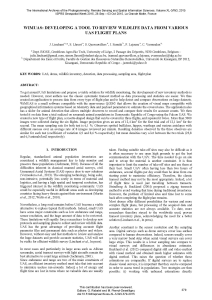Linchant J., Lhoest S., Quevauvillers S., Semek J., Lejeune P., Vermeulen C.
To get around UAS limitations and propose a viable solution for wildlife monitoring, the development of new inventory methods is needed. However, most authors use the classic systematic transect method as data processing and statistics are easier. We thus created an application to process data from every type of flight plan and to help detect and compare observations on large datasets. WiMUAS is a small software compatible with the open-source QGIS© that allows the creation of visual maps compatible with geographical information systems based on telemetry data and payload parameters to estimate the covered area. The application also has a slider for animal detection that allows multiple observers to record and compare their results for accurate counts. We then tested it on data from a trial realized on savannah animal populations in Democratic Republic of Congo using the Falcon UAS. We created a new type of flight plan, a rosette-shaped design that can be covered in three flights,.and repeated it twice. More than 5000 images were collected during the six flights. Image projection gives an area of 12,4 km² for the first trial and of 12,1 km² for the second. The mean sampling rate for both test is 6,1 %. Observers spotted buffaloes, hippos, warthogs and various antelopes with
different success over an average rate of 8 images reviewed per minute. Resulting densities observed by the three observers are similar for each test (coefficient of variation 6,9 and 8,6 % respectively) but mean densities vary a lot between the two trials (23,8 and 6,5 animals/km² respectively).
Consultez la notice complète de l’article sur ORBi

